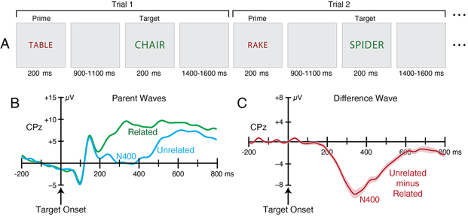Studio Tutorial: Design of the Example Experiment - ucdavis/erplab GitHub Wiki
This tutorial uses data from 6 subjects from the N400 paradigm in the ERP CORE dataset. To make this tutorial simpler, we've done some minor preprocessing to the data. We will explain how to download the preprocessed data on the next page. This section will provide a brief overview of the experimental paradigm and event codes.
The figure below (from Advanced ERP Data Analysis) shows the design of the N400 experiment and the grand average ERP waveforms from the CPz electrode site. The experiment involved a sequence of trials, each of which consisted of a prime word followed by a target word. The participants’ task was to press one of two buttons on each trial to indicate whether the target was semantically related or semantically unrelated to the preceding prime word. For example, they would press the related button for CHAIR preceded by TABLE and the unrelated button for SPIDER preceded by RAKE. Additional methodological details can be found in the original ERP CORE journal article.

Many studies have shown that a word will elicit a larger N400 component if it is semantically unrelated to the preceding word. This is exactly what was found in the present experiment. Panel B of the figure above shows that the ERP waveform for target words that were related or unrelated to the preceding prime word. As in previous research, the voltage was more negative from ~200-600 ms for the unrelated targets than for the related targets (but the overall waveform was positive because of other ERP components during that time period). This can also be visualized in Panel C, which shows the unrelated-minus-related difference wave. Note that the shaded area around the waveform shows the standard error of the mean at each time point.
The table below lists the event codes for the N400 experiment. An event code was produced for each prime word and each target word, and different codes were used depending on whether the target was semantically related or unrelated to the prime on that trial. Note that we used two different lists of words (for counterbalancing purposes), and that was also indicated by the event codes. An event code was also generated for each buttonpress response, with a code of 201 for correct responses and 202 for incorrect responses. Thus, a sequence of three event codes occurred on each trial (prime, target, and response).
| Word Type | Relatedness | Word List | Event Code | Occurrences | |
|---|---|---|---|---|---|
| Stimuli | Prime | Related | List 1 | 111 | 30 |
| Prime | Related | List 2 | 112 | 30 | |
| Prime | Unrelated | List 1 | 121 | 30 | |
| Prime | Unrelated | List 2 | 122 | 30 | |
| Target | Related | List 1 | 211 | 30 | |
| Target | Related | List 2 | 212 | 30 | |
| Target | Unrelated | List 1 | 221 | 30 | |
| Target | Unrelated | List 2 | 222 | 30 | |
| Accuracy | Event Code | ||||
| Responses | correct | 201 | Variable | ||
| incorrect | 202 | Variable |
You can see these event codes in the screenshot below, which shows a 5-second period of EEG data. Event code 121 (a prime from list 1 that will be followed by an unrelated target) is followed by event code 221 (a target from list 2 that was preceded by an unrelated prime) and then by event code 201 (a correct response).

| Previous Page | Next Page | 🏠 |
|---|---|---|
|
Load and View Data |
Home |